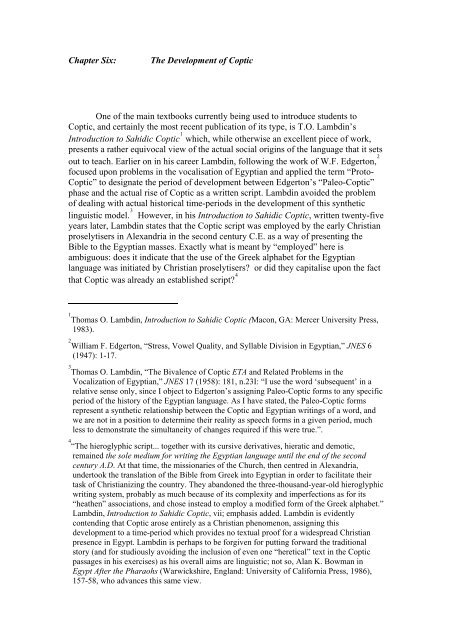THE EGYPTIAN FOUNDATIONS OF GNOSTIC THOUGHT
THE EGYPTIAN FOUNDATIONS OF GNOSTIC THOUGHT
THE EGYPTIAN FOUNDATIONS OF GNOSTIC THOUGHT
You also want an ePaper? Increase the reach of your titles
YUMPU automatically turns print PDFs into web optimized ePapers that Google loves.
Chapter Six: The Development of Coptic<br />
One of the main textbooks currently being used to introduce students to<br />
Coptic, and certainly the most recent publication of its type, is T.O. Lambdin’s<br />
Introduction to Sahidic Coptic 1<br />
which, while otherwise an excellent piece of work,<br />
presents a rather equivocal view of the actual social origins of the language that it sets<br />
out to teach. Earlier on in his career Lambdin, following the work of W.F. Edgerton, 2<br />
focused upon problems in the vocalisation of Egyptian and applied the term “Proto-<br />
Coptic” to designate the period of development between Edgerton’s “Paleo-Coptic”<br />
phase and the actual rise of Coptic as a written script. Lambdin avoided the problem<br />
of dealing with actual historical time-periods in the development of this synthetic<br />
linguistic model. 3<br />
However, in his Introduction to Sahidic Coptic, written twenty-five<br />
years later, Lambdin states that the Coptic script was employed by the early Christian<br />
proselytisers in Alexandria in the second century C.E. as a way of presenting the<br />
Bible to the Egyptian masses. Exactly what is meant by “employed” here is<br />
ambiguous: does it indicate that the use of the Greek alphabet for the Egyptian<br />
language was initiated by Christian proselytisers? or did they capitalise upon the fact<br />
that Coptic was already an established script? 4<br />
1<br />
Thomas O. Lambdin, Introduction to Sahidic Coptic (Macon, GA: Mercer University Press,<br />
1983).<br />
2<br />
William F. Edgerton, “Stress, Vowel Quality, and Syllable Division in Egyptian,” JNES 6<br />
(1947): 1-17.<br />
3<br />
Thomas O. Lambdin, “The Bivalence of Coptic ETA and Related Problems in the<br />
Vocalization of Egyptian,” JNES 17 (1958): 181, n.23I: “I use the word ‘subsequent’ in a<br />
relative sense only, since I object to Edgerton’s assigning Paleo-Coptic forms to any specific<br />
period of the history of the Egyptian language. As I have stated, the Paleo-Coptic forms<br />
represent a synthetic relationship between the Coptic and Egyptian writings of a word, and<br />
we are not in a position to determine their reality as speech forms in a given period, much<br />
less to demonstrate the simultaneity of changes required if this were true.”.<br />
4<br />
“The hieroglyphic script... together with its cursive derivatives, hieratic and demotic,<br />
remained the sole medium for writing the Egyptian language until the end of the second<br />
century A.D. At that time, the missionaries of the Church, then centred in Alexandria,<br />
undertook the translation of the Bible from Greek into Egyptian in order to facilitate their<br />
task of Christianizing the country. They abandoned the three-thousand-year-old hieroglyphic<br />
writing system, probably as much because of its complexity and imperfections as for its<br />
“heathen” associations, and chose instead to employ a modified form of the Greek alphabet.”<br />
Lambdin, Introduction to Sahidic Coptic, vii; emphasis added. Lambdin is evidently<br />
contending that Coptic arose entirely as a Christian phenomenon, assigning this<br />
development to a time-period which provides no textual proof for a widespread Christian<br />
presence in Egypt. Lambdin is perhaps to be forgiven for putting forward the traditional<br />
story (and for studiously avoiding the inclusion of even one “heretical” text in the Coptic<br />
passages in his exercises) as his overall aims are linguistic; not so, Alan K. Bowman in<br />
Egypt After the Pharaohs (Warwickshire, England: University of California Press, 1986),<br />
157-58, who advances this same view.










